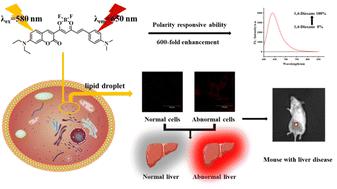当前位置:
X-MOL 学术
›
J. Mater. Chem. B
›
论文详情
Our official English website, www.x-mol.net, welcomes your
feedback! (Note: you will need to create a separate account there.)
An ultrasensitive lipid droplet-targeted NIR emission fluorescent probe for polarity detection and its application in liver disease diagnosis
Journal of Materials Chemistry B ( IF 6.1 ) Pub Date : 2022-08-09 , DOI: 10.1039/d2tb01145j Yonghe Tang 1 , Sirui Song 1 , Juanjuan Peng 1 , Qian Zhang 1 , Weiying Lin 1
Journal of Materials Chemistry B ( IF 6.1 ) Pub Date : 2022-08-09 , DOI: 10.1039/d2tb01145j Yonghe Tang 1 , Sirui Song 1 , Juanjuan Peng 1 , Qian Zhang 1 , Weiying Lin 1
Affiliation

|
Compared to normal cells, cancer cells require more energy supply during proliferation and metabolism. In living cells, in addition to mitochondria, lipid droplets are also an important organelle for providing energy. Studies have shown that the number and distribution of lipid droplets change significantly during the production of lesions in cells. At this stage, the predisposing factors for the development of cellular lesions are not clear, thus leading to limitations in the early diagnosis and treatment of diseases such as liver injury, fatty liver, and hepatitis. To meet the urgent challenge, we used a near-infrared emission fluorescent probe SSR-LDs based on the intramolecular charge transfer effect (ICT) to detect polarity changes within intracellular lipid droplets. The probe SSR-LDs has ultra-sensitive polarity sensitivity, excellent chemical stability and photo-stability. In addition, by comparing normal and cancer cells through cell imaging experiments, we found that the robust probe has the ability to sensitively monitor the changes in lipid droplet polarity in the living cells. More importantly, using the constructed fluorescent probe, we have achieved an in vitro fluorescence detection of liver injury and fatty liver, and the detection of hepatitis at the in vivo level. The unique fluorescent probe SSR-LDs is expected to serve as a powerful tool for the medical diagnosis of diseases related to lipid droplet polarity.
中文翻译:

一种用于极性检测的超灵敏脂滴靶向近红外发射荧光探针及其在肝病诊断中的应用
与正常细胞相比,癌细胞在增殖和新陈代谢过程中需要更多的能量供应。在活细胞中,除了线粒体,脂滴也是提供能量的重要细胞器。研究表明,在细胞内产生病变的过程中,脂滴的数量和分布发生了显着变化。现阶段细胞病变发生的诱发因素尚不明确,导致肝损伤、脂肪肝、肝炎等疾病的早期诊断和治疗受到限制。为了应对紧迫的挑战,我们使用基于分子内电荷转移效应 (ICT)的近红外发射荧光探针SSR-LD来检测细胞内脂滴内的极性变化。探头SSR-LD具有超灵敏的极性灵敏度、优异的化学稳定性和光稳定性。此外,通过细胞成像实验比较正常细胞和癌细胞,我们发现坚固的探针能够灵敏地监测活细胞中脂滴极性的变化。更重要的是,利用构建的荧光探针,我们实现了肝损伤和脂肪肝的体外荧光检测,以及体内水平的肝炎检测。独特的荧光探针SSR-LDs有望作为与脂滴极性相关疾病的医学诊断的有力工具。
更新日期:2022-08-09
中文翻译:

一种用于极性检测的超灵敏脂滴靶向近红外发射荧光探针及其在肝病诊断中的应用
与正常细胞相比,癌细胞在增殖和新陈代谢过程中需要更多的能量供应。在活细胞中,除了线粒体,脂滴也是提供能量的重要细胞器。研究表明,在细胞内产生病变的过程中,脂滴的数量和分布发生了显着变化。现阶段细胞病变发生的诱发因素尚不明确,导致肝损伤、脂肪肝、肝炎等疾病的早期诊断和治疗受到限制。为了应对紧迫的挑战,我们使用基于分子内电荷转移效应 (ICT)的近红外发射荧光探针SSR-LD来检测细胞内脂滴内的极性变化。探头SSR-LD具有超灵敏的极性灵敏度、优异的化学稳定性和光稳定性。此外,通过细胞成像实验比较正常细胞和癌细胞,我们发现坚固的探针能够灵敏地监测活细胞中脂滴极性的变化。更重要的是,利用构建的荧光探针,我们实现了肝损伤和脂肪肝的体外荧光检测,以及体内水平的肝炎检测。独特的荧光探针SSR-LDs有望作为与脂滴极性相关疾病的医学诊断的有力工具。





















































 京公网安备 11010802027423号
京公网安备 11010802027423号